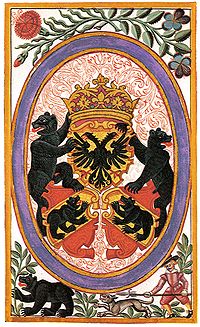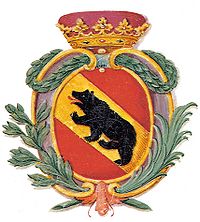
Heraldry of Berne
Encyclopedia

City
A city is a relatively large and permanent settlement. Although there is no agreement on how a city is distinguished from a town within general English language meanings, many cities have a particular administrative, legal, or historical status based on local law.For example, in the U.S...
, the canton and the district of Bern, is on a red field a yellow diagonal band charged with a black bear
Bear
Bears are mammals of the family Ursidae. Bears are classified as caniforms, or doglike carnivorans, with the pinnipeds being their closest living relatives. Although there are only eight living species of bear, they are widespread, appearing in a wide variety of habitats throughout the Northern...
walking upwards toward the hoist. The heraldic blazon
Blazon
In heraldry and heraldic vexillology, a blazon is a formal description of a coat of arms, flag or similar emblem, from which the reader can reconstruct the appropriate image...
reads: Gules, on a bend or, a bear passant sable, langued, armed and vilené of the field.
The flag of Bern is square and depicts the coat of arms. The heraldic colours of Bern are red and black.
Heraldic beast

Bear
Bears are mammals of the family Ursidae. Bears are classified as caniforms, or doglike carnivorans, with the pinnipeds being their closest living relatives. Although there are only eight living species of bear, they are widespread, appearing in a wide variety of habitats throughout the Northern...
. It has long served as namesake, emblem, mascot and — at times — personification of Bern. The founding legend has it that Duke Berchtold V of Zähringen
Zähringen
Zähringen is the name of an old German family that founded a large number of cities in what are today Switzerland and Baden-Württemberg. While the junior line that first assumed the title Duke of Zähringen, a cadet branch of the House of Baden, became extinct in 1218, the senior line persists and...
vowed to choose as namesake the first animal his hunt met in the wood that was to be chopped down for the new city. Then, as Konrad Justingers chronicle puts it:
- Nu wart des ersten ein ber gevangen, darumb wart die stat bern genempt; und gab do den burgeren in der stat ein wappen und schilt, nemlich einen swarzen bern in einem wissen schilt in gender wise.
- Then they caught a bear first, which is why the city was called Bern; and so the citizens had their coat and shield, which was a black bear in a white shield, going upright.
The bear motif is in evidence as early as 1224 (on city seals), and has remained in use ever since. Today the city of Bern still has bears featured directly outside its Altstadt
Altstadt
Altstadt is the German language word for "old town", meaning "historical city centre within the city wall", in contrast to a Neustadt built outside later....
in the Bärengraben
Bärengraben
The Bärengraben, or Bear Pit, is a well-known tourist attraction, an enclosure housing bears at the eastern edge of the Old City of Bern, next to the Nydeggbrücke and the Aare River. The bear is a symbol of Bern, both the city and canton, and is featured in Bern's coat of arms.The first records of...
.
Coat of arms

Berlin
Berlin is the capital city of Germany and is one of the 16 states of Germany. With a population of 3.45 million people, Berlin is Germany's largest city. It is the second most populous city proper and the seventh most populous urban area in the European Union...
). In the 13th century, the coat of arms changed to the one in use today. The modern coat of arms is already recognisable in Alsatian
Alsace
Alsace is the fifth-smallest of the 27 regions of France in land area , and the smallest in metropolitan France. It is also the seventh-most densely populated region in France and third most densely populated region in metropolitan France, with ca. 220 inhabitants per km²...
mercenary songs of 1375 reported by Justinger. The change, according to the chroniclers, was linked to the Battle of the Schosshalde in 1289 against the troops of Duke Rudolf II of Austria, son of Emperor Rudolf II von Habsburg
Rudolf II, Holy Roman Emperor
Rudolf II was Holy Roman Emperor , King of Hungary and Croatia , King of Bohemia and Archduke of Austria...
. According to Justinger, a Bernese salvaged a part of the ensign as the fortunes of war turned against Bern, and Tschudi
Aegidius Tschudi
Aegidius Tschudi was an eminent member of the Tschudi family, of Glarus, Switzerland....
recounts:
- Und als die von Bern bis ze der zit in ir paner den bern in wijssem veld gefuert, wars damals verendert in ein rot veld, von wegen das die paner ... von bluot was rot worden.
- Until then, those of Bern carried the bear in a white field, but the field turned red that day, as the banner was drenched in blood.
The chronicler Stumpf
Stumpf
-People:* Carl Stumpf, German Philosopher and Psychologist* Eddie Stumpf, American professional baseball player, manager and executive* Johann Walter Stumpf , Master Pipe Organist, German Immigrant...
then adds that the diagonal band changed from silver to gold to celebrate the eventual Bernese victory over the House of Habsburg.

Holy Roman Empire
The Holy Roman Empire was a realm that existed from 962 to 1806 in Central Europe.It was ruled by the Holy Roman Emperor. Its character changed during the Middle Ages and the Early Modern period, when the power of the emperor gradually weakened in favour of the princes...
, subject to the Emperor, this was reflected in its coat of arms. The imperial eagle was placed above the Bernese shield, constituting a compound coat of arms known as the Bern-Rych, or "Berne-Empire". Eventually, Bern formally gained the full sovereignty
Sovereignty
Sovereignty is the quality of having supreme, independent authority over a geographic area, such as a territory. It can be found in a power to rule and make law that rests on a political fact for which no purely legal explanation can be provided...
it had long since de facto possessed with the Peace of Westphalia
Peace of Westphalia
The Peace of Westphalia was a series of peace treaties signed between May and October of 1648 in Osnabrück and Münster. These treaties ended the Thirty Years' War in the Holy Roman Empire, and the Eighty Years' War between Spain and the Dutch Republic, with Spain formally recognizing the...
in 1648, but it was not until 1700 that the eagle was replaced with the Republic's trefoil crown that signified ultimate temporal power. This crown is still used by the canton, which places it on top of the coat of arms on its official documents. The city of Bern uses a mural crown
Mural crown
-Usage in ancient times:In Hellenistic culture, a mural crown identified the goddess Tyche, the embodiment of the fortune of a city, familiar to Romans as Fortuna...
on top of its coat of arms, while the district uses no crown.
Other flags of Bern
The war flag of the Ancien RégimeEarly Modern Switzerland
The early modern history of the Old Swiss Confederacy , lasting from formal independence in 1648 to the French invasion of 1798 came to be referred as Ancien Régime retrospectively, in post-Napoleonic Switzerland.The early modern period was characterized by an increasingly...
, depicting a white cross on black and red flames, is sometimes flown in lieu of or alongside the state flag.
A flag for the Bernese Oberland
Bernese Oberland
The Bernese Oberland is the higher part of the canton of Bern, Switzerland, in the southern end of the canton: The area around Lake Thun and Lake Brienz, and the valleys of the Bernese Alps .The flag of the Bernese Oberland consists of a black eagle in a gold field The Bernese Oberland (Bernese...
, designed by B. v. Rodt, was accepted as official by the Bernese Executive Council in 1953. It consists of a black eagle in a gold field (in reference to the region's old status as reichsfrei
Reichsfreiheit
Imperial immediacy was a privileged feudal and political status, which the estates of the realm such as an imperial city, a religious entity, a feudal principality, or a minor lordship could attain within the Holy Roman Empire...
) over two fields in the cantonal colours of red and black. As opposed to most other Swiss flags, which are quadratic, the flag's format is specified as "an upright oblong in the proportions of 23 to 26".
See also

- History of Bern
- BerlinBerlinBerlin is the capital city of Germany and is one of the 16 states of Germany. With a population of 3.45 million people, Berlin is Germany's largest city. It is the second most populous city proper and the seventh most populous urban area in the European Union...
, Bern's sister capital (of GermanyGermanyGermany , officially the Federal Republic of Germany , is a federal parliamentary republic in Europe. The country consists of 16 states while the capital and largest city is Berlin. Germany covers an area of 357,021 km2 and has a largely temperate seasonal climate...
), has a remarkably similar heraldic history.
Literature
Most of this article has been adapted from: Pascal Ladner, Siegel und Heraldik, in: Rainer C. Schwinges (ed.), Berns mutige Zeit: Das 13. und 14. Jahrhundert neu entdeckt, Bern, Schulverlag blmv AG und Stämpfli Verlag AG, Bern 2003, ISBN 3-292-00030-0 and ISBN 3-7272-1272-1, p. 244-245.External links
- Berne at Flags of the WorldFlags of the WorldFlags of the World is an Internet-based vexillological association and resource. Its principal project is the Internet's largest website devoted to vexillology, containing comprehensive information about all kinds of flags, and an associated mailing list...

